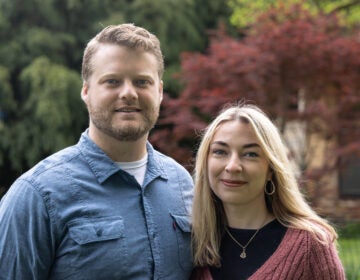The woman behind the many murals in Pennsylvania’s State Capitol
On St. George’s Road, a historic marker commemorates “Cogslea”, the home of an American artist and pioneering female Philadelphian. But given the choice, she might not have moved to Mt. Airy at all.
At the turn of the century, on the cusp of a brilliant career, Violet Oakley (born in New Jersey in 1874) moved into a Villanova building known as the Red Rose Inn. She and three resident companions, including Jessie Willcox Smith and Elizabeth Shippen Green (noted illustrators in their own right), became known as the “Red Rose Girls”.
State Capitol murals
Within a year, Oakley received a remarkable commission: murals for the Governor’s Reception Room in the new Pennsylvania State Capitol in Harrisburg – the most prestigious assignment ever given to a female artist in America.
Pennsylvania Governor Samuel Pennypacker and Capitol architect Joseph Huston had plenty of recommendations for the topic of Oakley’s new murals, but Oakley prevailed with her own vision of the life of William Penn, emphasizing his original Quaker vision of social freedom and religious tolerance. The eighteen murals took four years to complete, and brought Oakley growing acclaim. But in 1906, Oakley and her Villanova colleagues received an eviction notice.
Goodbye Villanova
Germantown author Juanita Taylor notes that many sources don’t speculate on the reason for the eviction. But in her research for her historical novel Cogslea Revisited, Taylor discovered an angry letter written by the owner of the Red Rose Inn at the time.
The Red Rose Girls were females with notable careers. And they were living together as women independent of a man. Taylor speculates that the landlord, like many others of his time, couldn’t abide the situation.
Hello Mt. Airy
Fortunately, a Chestnut Hill landowner felt differently. After renovations by architect Frank Miles Day, The Red Rose Girls moved into Cogslea in Mt. Airy, whose stable had been converted to an artists’ studio. The name was an acronym for the residents: “C” for Henrietta Cozens (friend, manager and housekeeper), “O” for Oakley, “G” for Elizabeth Shippen Green and “S” for Jessie Willcox Smith. The “lea” represented the pasture where their new home was situated.
Before writing her novel about a fictional modern protagonist who awakens the ghosts of Cogslea’s past, Taylor felt drawn to the property and the overwhelming sense that “there was a story there.” She wanted to explore the ways real-life female artists of the past met obstacles to their work in the social and religious expectations of their times.
Oakley’s early life
Oakley began life with more than her share of challenges. Her oldest sister died of diphtheria before her first birthday. Following this tragedy, Oakley’s asthma cemented her parents’ protectiveness, and she was schooled at home. While her surviving older sister, Hester, attended Vassar, Oakley was not allowed to follow.
But at age 20, Oakley got a taste of the artistic education she craved with a family trip to Paris in 1895, where she and Hester enrolled at the Académie Montparnasse, a women’s painting school. Male models, as well as any nude figures, were forbidden in the women’s lessons. Unable to study at the premier male-only Académie des Beaux-Arts, the sisters also experienced the dispute within their own academy about whether fresh air was good for women.
Her artistic achievements
Eventually, Oakley’s career as a muralist would include 43 murals commissioned for the Pennsylvania Capitol, work which would span 25 years. For a 1911 Senate Chamber and Supreme Court Room contract, Oakley earned an unprecedented $100,000. Her work continued into her seventies, with a ten-panel series (completed in 1949) titled “Great Women of the Bible” for the First Presbyterian Church in Germantown.
Beyond her art career, Oakley was an outspoken advocate of women’s rights and became the second woman ever to teach at the Pennsylvania Academy of Fine Arts. She lived at Cogslea until her death in 1961.
Woodmere exhibit
Now, Germantown Avenue’s Woodmere Art Museum offers a special exhibition of Oakley’s paintings from her time in Paris, side by side with similar works by female Impressionists whose work Oakley would have encountered in Paris, including Berthe Moriscot and Mary Cassatt.
The Woodmere is also hosting a stunning set of Oakley murals, on display together for the first time. Commissioned, designed and painted in 1910-11 for a Locust Street mansion owned by Charlton Yarnall, the pieces are titled “The Building of the House of Wisdom”, and in panels of varying shape and size, Oakley expounds in glorious Renaissance style on the achievements of human society, including the roots of literature, where Confucius, Cicero, Solomon and Dante lurk as a young boy reads a book with his mother and nurse. In other panels, the boy becomes a youth who celebrates the joy of music, and then a man with a family of his own, contemplating images of technological innovation like the light-bulb, the telegraph and the aviator. Other panels celebrate mankind’s architectural progress, from tents to pyramids to the Renaissance dome (a painting of the early-20th century skyscraper has been lost).
Transfixed by the Yarnall House murals, Hildy Tow, Woodmere’s Assistant Curator of Education, admires not just the paintings’ artistic, technological and literary merit, but Oakley’s vision of “how you become a whole human being.”
The crowning piece of the Yarnall House murals, which has been lost, was a stained-glass window depicting “Wisdom” as a strong, “beloved and desirable” woman. Taylor admires the powerful religious and patriotic women that Oakley portrayed throughout her career. “Considering the times and her abilities, I so admire her for pursuing her career as well as her personality,” Taylor says. “I wish I had known her.”
The exhibit on Violet Oakley runs through June 26 at the Woodmere Art Museum.
Juanita Taylor’s Cogslea Revisited is available on Amazon.
WHYY is your source for fact-based, in-depth journalism and information. As a nonprofit organization, we rely on financial support from readers like you. Please give today.




